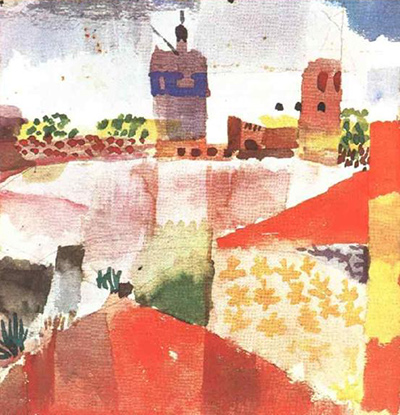Hammamet is a small town in the northwest of Tunisia and Klee visited this place in April of the year 1914.
Hammamet with Mosque is a depiction of the small town and its surroundings. The painting is a watercolour and Klee created this piece from beyond the walls of the town.
Klee's work often includes abstract and representational elements and this painting is no exception. The top section of the painting consists of the mosque with towers and gardens surrounding it. The bottom section is a combination of translucent colour contrasting with each other which becomes a very important part of the painting.
Hammamet has rich history and was an excellent topic for Klee to paint. Hammamet became a Roman colony in the 2nd century and the walls of the town were not built until the 13th century.
It was in the 15th century that Hammamet was ruled by Spanish and Turkish powers. Much later on in the 1600's, Hammamet was attacked by the Spanish. The town was referred to as La Mahometa by the Spanish.
Paul Klee himself was born in 1879 and passed away in 1940. Klee's nationaly was Swiss-German. The movements that inspired Klee the most included Eexpressionism and Surrealism.
He appreciated deeply the colour theory and used it extensively not only in his artistic works but in his academic work as well. Klee's pieces often reflect his unique dry, sarcastic humour and at times his childlike outlook on the world. Like many artists, his works also reflected his principles, moods and beliefs.
Paul Klee is known for abstract painting and his unique style is consistent throughout all of his paintings. Klee trained and developed his style in Munich in 1898 where he became accustomed with artistic techniques for three years.
This training approximately lasted until 1914 which is the year he visited Tunisia. The place inspired him heavily and he took a lot of impressions from the colour of the country. Klee stated "Colour and I are one. I am a painter." At this point.




